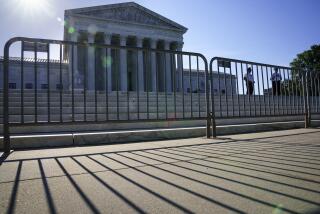Honor the People, Protect the Court : The Case for One 12-Year Term, With State Senate Approval
- Share via
This year’s vote on California Supreme Court justices marked a dramatic change in the nature of judicial elections in the state. For the first time since retention elections began 50 years ago, voters rejected three sitting members of our highest court, including the chief justice, Rose Elizabeth Bird.
Now that the elections are behind us and passions can begin to cool, we should examine this campaign to see what lessons we can learn:
The death penalty was the decisive issue in the defeat of Bird and Associate Justices Joseph Grodin and Cruz Reynoso. The emotional power of the death penalty as a political issue is so great that it overwhelmed all other considerations in this election. Correctly or not, many voters believe that the Supreme Court substituted its own ideological views for those of the public on this issue. This was the most powerful argument against the justices who were defeated. Voters do not expect the court to uphold every death penalty, but neither will the public tolerate members of the court who rely on overly technical reasons to avoid implementing the law.
Voters are dissatisfied with the way our legal system is working. While the death penalty was the key issue, I believe that the vote was in some ways a reflection of peoples’ feelings about the legal system in general: They believe that it is more obsessed with procedure than with justice, and is too slow and too expensive and seems incapable of accepting laws passed by the voters or by the Legislature.
Supreme Court justices make lousy politicians . The spectacle of justices addressing political rallies, hiring press secretaries and make-up artists and soliciting campaign contributions is inconsistent with the role of judges as dispassionate and impartial arbiters of justice existing above the political fray.
Unlike other candidates, judges are prohibited from expressing their personal views on any issues that may come before the court. Operating under very strict canons of ethical conduct, they cannot make the very campaign statements or promises that we expect of political candidates.
Given these conclusions, how do we protect the independence of the judiciary while ensuring that the concerns of the body politic are not completely ignored?
It may be tempting to view the removal of Bird, Grodin and Reynoso as a kind of public referendum on judicial independence. However, I do not believe that the electorate, in removing these three particular judges, intended to completely reject the principle of an independent judiciary that has served this country so well.
Our goal in California should be to establish a balance that protects the justices from the potentially corrupting influences of politics but also provides some assurance that the court will not become completely out of touch with the citizens of this state.
Adopting the federal system, which would eliminate confirmation elections altogether, would assure an independent judiciary. I don’t believe that this approach reflects the will of California’s voters. As an alternative, I would like to suggest three possible reforms that could accommodate the conflicting demands that we make on our Supreme Court.
To begin, we could limit all Supreme Court appointments to a single 12-year term. I also recommend confirmation for all such appointments by a two-thirds vote of the state Senate, after action by the Commission on Judicial Appointments. Finally, I would permit each new California governor to select a new chief justice from among the members of the court.
A single term would relieve justices of having to play politician or chase campaign contributions. This system has two other advantages. At present, the number of appointments that a governor makes is determined by chance, dependent on deaths or resignations that occur during the governor’s term of office. A staggered single-term approach would ensure that each governor gets a fair share of appointments. This regular turnover on the court would help to prevent it from becoming too removed from the interests and the attitudes of the voters.
Senate confirmation is used on the federal level but not in our current state system. Instead, the governor makes the appointment and confirmation is granted by the three-member Commission on Judicial Appointments. Requiring two-thirds of the state Senate to confirm the governor’s appointment, after the commission has acted, would subject nominees to more intense public scrutiny. The two-thirds vote requirement would also require a governor to exercise a certain amount of ideological moderation in appointments in order to ensure confirmation. Although it is obviously not a perfect system, it does offer some “checks and balances” not present in California today.
As to the regular rotation of the chief justice, I believe that such a system could have avoided a lot of the trauma that Bird’s tenure brought to the court. By giving each new governor the option to rotate the chief justiceship among those already on the court, no single justice could administer or lead the court for an unreasonable length of time.
California is now at a crossroads in the way we evaluate the qualifications of our Supreme Court justices. Rather than sitting back to watch the anti-Bird forces plan their next judicial targets and the pro-Bird forces shake their heads in frustration at the ignorance of the voters, wouldn’t it be preferable to forge a new consensus on the role of the state Supreme Court that strikes a proper balance between judicial independence and accountability?
More to Read
Get the L.A. Times Politics newsletter
Deeply reported insights into legislation, politics and policy from Sacramento, Washington and beyond. In your inbox twice per week.
You may occasionally receive promotional content from the Los Angeles Times.









